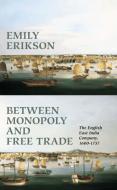
- Publisher Link
- Interview on The MacMillan Report, Erikson speaks about her award-winning book, ”Between Monopoly and Free Trade: The English East India Company, 1600-1757.
The English East India Company was one of the most powerful and enduring companies in history. This book locates the source of that success in the innovation and internal cohesion generated through what was initially a cost-saving measure, in which the court of directors granted employees the right to pursue their own commercial interests while in the employ of the firm.
Though the Company held a monopoly on English overseas trade to Asia, the Court of Directors extended the right to trade within Asia to their employees, creating an unusual situation in which employees both worked for themselves and for the Company as overseas merchants. Building on the organizational infrastructure of the English Company and the institutional base of the rich and sophisticated market of the East, the employees built a cohesive internal network of peer communications, i.e. a social network, that was used to direct English trading ships during their voyages. This network integrated Company operations, encouraged innovation, and increased the Company’s flexibility, adaptability, and responsiveness to local circumstance.
The book thus provides an answer to the historical puzzle of why the English East India Company was such a singularly dynamic force in the expansion of trade between Europe and Asia. This puzzle is particularly compelling because it is nested within the larger historical questions of why Western Europe experienced a unique trajectory of rapid economic development and how the relationship between Europe and Asia came to shift so rapidly in the eighteenth and nineteenth centuries.
The argument is built upon an analysis of trade network dynamics, a statistical investigation of decision-making processes, and institutional analysis of ports and organizational context. This multi-method approach is designed to link macro and micro levels of analysis by offering an explanation of large-scale historical change in the world economy rooted in mechanisms operating at the level of the individuals that participated in that change.
The central theoretical issues addressed are (1) the role of social networks, organizations, and decentralization in historical change and trade expansion (2) the role of the Asian institutional context in fostering early-modern European commercial expansion.